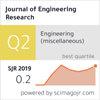新型Al-Si-Mg纳米复合材料的多目标优化:Taguchi-ANN-NSGA-II方法
IF 0.9
4区 工程技术
Q3 ENGINEERING, MULTIDISCIPLINARY
引用次数: 0
摘要
环境污染在全世界都是一个大问题。减少环境污染威胁的策略之一是发展循环经济的概念,其主旨是废物转化为财富的概念。本研究的目的是优化从废饮料罐中提取的Al-Si-Mg合金、从稻壳中提取的碳纳米管和从长春花贝壳中提取的纳米颗粒制备的新型纳米复合材料的生产。采用田口法、人工神经网络(ANN)和非支配排序遗传算法(NSGA-II)对新型复合材料的孔隙度、硬度和抗压强度进行了多目标优化。人工神经网络使用以下输入参数:CNTs的重量百分比(wt%)、PWSnp的重量百分比(wt%)、搅拌速度(rpm)和搅拌时间(min)。人工神经网络预测的结果为:孔隙率、硬度、抗压强度。为了获得最佳的孔隙率、硬度和抗压强度,采用田口灰关联法同时优化复合材料的生产参数。确定的最佳值为:CNTs加入量为1.5 wt%, PWSnp加入量为1.0 wt%,搅拌速度为100 rpm,搅拌时间为6 min,孔隙率、硬度和抗压强度分别为0.3250、108.2738和410.6436。人工神经网络对复合材料的孔隙率、硬度和抗压强度的相关系数分别为0.9617、0.9536和0.9725,具有良好的预测能力。其次,利用神经网络作为NSGA-II中的适应度函数,对新材料的孔隙率、硬度和抗压强度进行多目标优化。由此得出的帕累托最优解和最佳生产参数为工程师设计最佳制动盘和其他机器部件提供了有价值的指导,利用新材料的优势特性。本文章由计算机程序翻译,如有差异,请以英文原文为准。
Multi objective optimization of novel Al-Si-Mg nanocomposites: A Taguchi-ANN-NSGA-II Approach
Environmental pollution is a big problem all over the world. One of the strategies to reduce the menace environmental pollution is the development of the concept of circular economy whose major thrust is the concept of conversion of waste to wealth. The aim of this research is to optimize the production of a new nanocomposite material developed from Al-Si-Mg Alloy derived from waste beverage cans, carbon nanotubes (CNTs) derived from rice husks and nanoparticles from periwinkle shells. The multi-objective optimization of the porosity, hardness and compressive strength of the novel composite was done using the Taguchi method, Artificial Neural Network (ANN), and Nondominated Sorting Genetic Algorithm-II (NSGA-II). The ANN utilized the following input parameters: Weight percentage (wt%) of CNTs, Weight percentage (wt%) of PWSnp, stirring speed (rpm) and Stirring time (minutes). The outputs predicted by the ANN were: Porosity, Hardness, Compressive strength. To achieve optimal porosity, hardness, and compressive strength, the Taguchi-grey relational methodology was employed to simultaneously optimize the production parameters of the composite. The optimal values determined were as follows: 1.5 wt% of CNTs, 1.0 wt% of PWSnp, 100 rpm stirring speed, and 6 min of stirring time with porosity, hardness, and compressive strength values of 0.3250, 108.2738 and 410.6436 respectively. The ANN demonstrated excellent predictive capability, exhibiting correlation coefficients of 0.9617, 0.9536, and 0.9725 for the porosity, hardness, and compressive strength of the composite material, respectively. Next, the ANN was utilized as a fitness function within NSGA-II to perform multi-objective optimization for the porosity, hardness, and compressive strength of the novel material. The resulting Pareto optimal solutions and the optimum production parameters serve as a valuable guide for engineers involved in the design of optimal brake discs and other machine components, utilizing the advantageous properties of the new material.
求助全文
通过发布文献求助,成功后即可免费获取论文全文。
去求助
来源期刊

Journal of Engineering Research
ENGINEERING, MULTIDISCIPLINARY-
CiteScore
1.60
自引率
10.00%
发文量
181
审稿时长
20 weeks
期刊介绍:
Journal of Engineering Research (JER) is a international, peer reviewed journal which publishes full length original research papers, reviews, case studies related to all areas of Engineering such as: Civil, Mechanical, Industrial, Electrical, Computer, Chemical, Petroleum, Aerospace, Architectural, Biomedical, Coastal, Environmental, Marine & Ocean, Metallurgical & Materials, software, Surveying, Systems and Manufacturing Engineering. In particular, JER focuses on innovative approaches and methods that contribute to solving the environmental and manufacturing problems, which exist primarily in the Arabian Gulf region and the Middle East countries. Kuwait University used to publish the Journal "Kuwait Journal of Science and Engineering" (ISSN: 1024-8684), which included Science and Engineering articles since 1974. In 2011 the decision was taken to split KJSE into two independent Journals - "Journal of Engineering Research "(JER) and "Kuwait Journal of Science" (KJS).
 求助内容:
求助内容: 应助结果提醒方式:
应助结果提醒方式:


